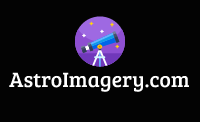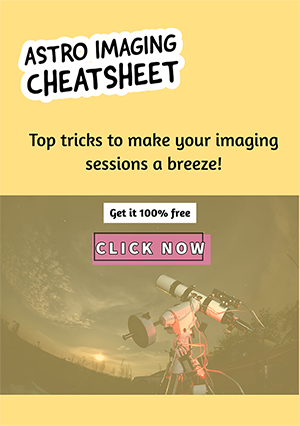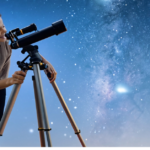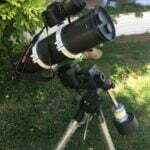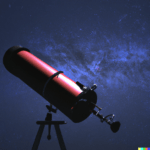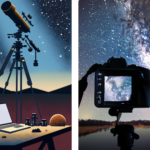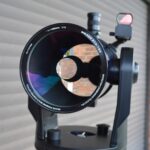Table of Contents
When someone seeks to enter the field of astronomy, they often become interested in astrophotography. Why? Well, it’s simple. The gorgeous photos of space we see online, often from supertelescopes from NASA or professional observatories, inspire aspiring astrophotographers. But amateurs at home can also take amazing photos of the night sky and planetary imaging, and that’s what I love about this pastime.
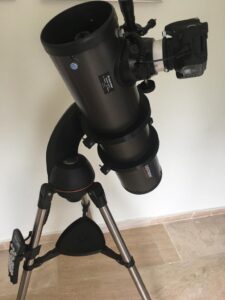
However, the first question that I often hear is, What is the best telescope for astrophotography? As we will see, this is not an easy question to answer and can be quite complex to discuss. However, if you are asking this question and looking for an answer, I will help you come to a conclusion that will be helpful in making a choice that is right for you. Briefly, though, here is a good answer:
The best telescope for astrophotography is the one that helps astrophotographers take the best images of astronomical targets. Two types of telescopes, refractors and reflectors, are commonly used for astrophotography. The quality of the optics, including camera lenses and mm eyepieces, as well as the sturdiness of the telescope mount, are two crucial factors to consider when selecting the best telescope for astrophotography.
If you are looking to buy the best telescope for astrophotography, a lot will depend on your current level of expertise. Are you a beginner with little or no experience, or have you tried astrophotography before and sought to improve? The equipment suitable for a beginner, intermediate, or advanced astrophotographer is very different! There is absolutely no point in trying to use equipment that is too advanced for you before you have learned the techniques to correctly use it. This is also a waste of your time and money and will cause much frustration!
Astrophotography is a complex pastime that can develop into a professional occupation if you take it that far. There is a long learning curve that is very steep at times. You’ll need to understand what your goals are and which targets you want to image before you can choose the best telescope for home use in your astrophotography journey.
Let’s look into the question of the best telescope for astrophotography, not by looking at facts you can find elsewhere, but by giving you my perspective as an astrophotographer who is familiar with the many choices and problems you may face when choosing and using your telescope and other astrophotography equipment. Hopefully, this will be much more practical for you than just reading about astrophotography telescopes in general.
What are the Different Types of Telescopes?
There are many different types of telescopes available on the market today, but not all of them will suit the needs of astrophotographers when it comes to visual astronomy. There’s an important distinction between a telescope that you would use for hunting or birdwatching and one that would be used for astrophotography. Eyepieces and refractors are essential tools for astrophotographers.
Let’s attempt to discover the best telescope for astrophotography by first comparing them. This will be particularly helpful for astrophotographers who are interested in visual astronomy and are looking for an astrograph review. Additionally, we will also consider the importance of high-quality eyepieces in this comparison.
On this page, I compare two kinds of telescopes, the Dobsonian and the Cassegrain. Find out which is the better choice for you.
The telescope is a powerful instrument that allows us to see the universe in great detail. However, the best telescope for astrophotography that is best for you depends on what you want to photograph. Ask yourself: do you want to photograph planets and the Moon or far-away deep sky objects such as galaxies and nebulae?
I wrote a post answering an interesting question: can galaxies be seen in a telescope? Go check out my answer.
Some telescopes will be great for both. The Celestron telescope I have, for example, can handle all these objects, but I do think that a good telescope for viewing planets and imaging them is a refractor telescope that doesn’t need to be too large. These objects are usually pretty bright, so they are easily focused on and observed. They can easily be found too, and exposures can be very short, so it is not necessary to have an expensive equatorial mount. An alt-az mount will do. More about mounts later.
If you have a telescope already or are thinking of buying one, click this link to learn about how to set up a telescope and camera for astrophotography.
Telescopes can be classified by size, shape, and design. The bigger the size, the more magnification it will have and the heavier it will be. So, which is the best telescope for astrophotography? It depends on how and where you plan to do your imaging. If you want to go out and carry your equipment or transport it by car, you don’t want it to be too heavy and bulky. Portable is best for you!
Yesterday I watched a very interesting and informative video that will give you an astrophotographer’s view of different kinds of telescopes and which ones are worth using. I hope this video will clear up a few confusions and give you a better idea of the choices you have when looking for the best telescope for astrophotography.
The main classifications of telescopes
Refractor Telescopes
These are the most common types of telescopes, which use lenses to collect light from objects in space. We’ll take a look later at the best refracting telescope.
A reflector telescope, also known as an optical telescope, uses mirrors and lenses to collect and focus light for sky astrophotography. These telescopes offer a more affordable alternative to refractor telescopes, but they require a bit more expertise to operate. With the wide variety of models available, it can be overwhelming to choose the best eyepiece for your needs. However, I can assist you in finding the ideal lens for your astrophotography endeavours.
Reflector telescopes
These are the most common types of telescopes in the world. They use two mirrors to collect and focus light from an object into an image. The first mirror is concave, or dish-shaped, and it collects the light from the object. This is also called the primary mirror and can be found at the rear end of your telescope. The second mirror is flat, and it reflects this light back up to a focal point where eyepieces are positioned for viewing. This is called the secondary mirror.
A reflector telescope, also known as a mirror telescope, can be more portable than other types of telescopes, such as refractor telescopes. Before considering what could be the best reflecting telescope for astrophotography, read on to learn more about the different types of telescopes and their components, like eyepieces.
One of the main disadvantages of reflector telescopes is that they require more maintenance than refracting or catadioptric telescopes. One aspect of this maintenance is collimation, which needs to be checked often. However, collimation is usually quick and easy, taking about 5 minutes with a laser collimation tool that fits over the eyepiece.
Given this information, can we figure out which is the best telescope for astrophotography? I think we still need to go deeper into this question before we can find an answer. Specifically, we need to consider factors such as the type of eyepiece, astrograph, camera, and refractor.
How to Choose the Best Telescope for Astrophotography
The first step in astrophotography is to decide what you plan on using your telescopes for. If you want to see distant galaxies, then a long-focus refractor telescope with a large aperture and a suitable eyepiece may be perfect for you.
Telescopes, such as the refractor and astrograph, are the best way to see the stars and other celestial objects in the sky. Telescopes come in a variety of shapes and sizes, with options like eyepieces to enhance your viewing experience. The type of telescope you choose will depend on your specific needs and budget.
Telescope Prices
The next step is deciding how much money you want to spend. Telescopes range from $50 all the way up to $400,000, depending on what features they have. The recently launched James Webb Telescope is the most advanced telescope of all, and the price is about 10 billion dollars and counting! I spent a couple of hundred dollars to acquire my Celestron telescope, a 130-mm reflector, and I still use it a year or so later. No need to spend thousands of dollars especially if you are in the early stages of your astrophotography journey!
Here is a detailed overview of some of the top telescopes for astrophotography currently available. I think it will definitely point you in the right direction. Or perhaps you don’t have the cash to spend and are looking for the best budget telescope?
Of course, a telescope is just one part of your setup for astrophotography. Here’s what you need to know about the cost of starting astrophotography: Go check it out now.
Research: What Telescope Would You Recommend for Astrophotography?
I decided to do some research and ask this question to those who have experience with astrophotography using a smart telescope, refractor telescope, or imaging telescope. I wanted to gather information for my telescope review.
The reason why I carried out this research is that after searching on Google.com for an answer to this question, all I found was a number of posts by websites listing their choice of the top 5 or so telescopes for astrophotography, which did not appear to be based on the actual user experience of the telescopes.
In order to provide something far more helpful to someone looking for an answer to this query, “What is the best telescope for astrophotography?” Here’s what I did: I researched different types of telescopes, including eyepieces, refractors, and astrographs. Then, I considered which one would be most compatible with a camera.
- I searched the internet for forum posts and opinions from actual amateur astrophotographers
- I asked forum members with experience in astrophotography what they considered the best telescope for astrophotography, either for a beginner or more advanced astrophotographer. I submitted my question to Cloudynights.com, Stargazerslounge.com, Quora, and forums.space.com. I am a member who regularly posts and answers astronomy questions on these sites.
- In all, I managed to locate and acquire 103 replies or answers to this question.
The results I got from the data I collected
| Recommended Telescope | Votes | Imager’s Level |
| ED refractors in the 72mm or 80mm range | 33% | beginner |
| Williams Optics RedCat | 14% | |
| Astro-Tech AT65EDQ or AT72ED | 13% | beginner |
| Orion CT-80 | 12% | beginner |
| ASTRO-TECH 6″ Newtonian | 7% | beginner |
| 4-inch apo refractor | 6% | beginner |
| Celestron C6 | 5% | |
| Astro-Tech AT80ED 80mm refractor | 4% | beginner |
| TEC 140 | 1% | experienced imager |
| SVX 152 | 1% | experienced imager |
| FRA400 | 1% | beginner DSO |
| APM 105/650 LZOS Triplet | 1% |
Some of the sources of the data (far too many to list all of them here)
- What-telescope-would-be-best-for-DSO-astrophotography?
- Post on CloudyNights
- Another Post on Stargazerslounge
- and so on…
How much is a good telescope for astrophotography?
So now you have a much better idea, I hope, of the kind of telescope, such as a camera, astrograph, or refractor, you’re looking for and what you plan to do with it. Now, it’s time to figure out which you think is the best telescope for astrophotography and then decide to buy it. To help you decide, I have listed the best 7 telescopes available on Amazon, including options from Orion.
1. Celestron NexStar 8SE
Click image above to go to Amazon (commission paid)
Experience the universe like never before with the NexStar 8SE. This powerful telescope boasts an impressive 8-inch aperture, paired with Celestron’s renowned Schmidt-Cassegrain optics. As you gaze through the lens, prepare to be mesmerized by the exceptional image quality and the telescope’s incredible ability to gather light. Every detail of celestial objects will come to life, inviting you to explore the mysteries of the cosmos.
Locating celestial wonders has never been easier. The NexStar 8SE features a state-of-the-art computerized GoTo mount, transforming the task of finding celestial objects into a seamless and enjoyable experience. With just a few clicks, you’ll effortlessly navigate through the vast expanse of the night sky, uncovering hidden gems along the way. Say goodbye to the frustration of searching aimlessly and embrace the thrill of discovery.
Buy from Amazon
2. SkyWatcher 10-inch Dobsonian
Click image above to go to Amazon (commission paid)
If you’re looking for a telescope that combines impressive aperture and convenience, this SkyWatcher 10-inch monster is worth considering. With its large 10-inch aperture and motorized GoTo system, this Dobsonian telescope offers a remarkable viewing experience.
It has a sturdy construction and precise tracking allow for effortless astrophotography sessions. Its fully computerized system can automatically locate and track celestial objects, freeing you to focus on capturing stunning images. With its excellent light-gathering capability and user-friendly features, the SkyWatcher 10 inch is a fantastic choice for astrophotographers of all levels.
Buy now from Amazon
3. Sky-Watcher ProED 80mm Doublet APO Refractor

Click image above to go to Amazon (commission paid)
The Sky-Watcher ProED 80mm is an impressive telescope that boasts a remarkable 80mm aperture and a doublet lens system. What sets this telescope apart is its use of extra-low dispersion (ED) glass, which greatly reduces chromatic aberration.
As a result, the images produced by the ProED 80mm are incredibly sharp and filled with contrast. One of the biggest benefits of this telescope is its ability to eliminate color fringing. With the ProED 80mm, you can say goodbye to those annoying streaks of color that often appear in other telescopes.
You will be treated to breathtaking visuals that bring the universe to life with remarkable clarity. Precision is key when it comes to focusing your telescope. And the ProED 80mm does not disappoint. It features a robust dual-speed Crayford focuser that allows for smooth operation and fine adjustments. This means that every detail will be crystal clear.
The Sky-Watcher ProED 80mm is a great choice and a great value too.
Buy this similar model from Amazon now
4. Meade Instruments LX90-ACF
If you’re a serious astrophotographer, the Meade Instruments LX90-ACF is the real deal. With its cutting-edge ACF (Advanced Coma-Free) optics and generous 12-inch aperture, this telescope delivers mind-blowing image quality, leaving minimal coma and astigmatism in its wake. Trust me, you won’t believe your eyes!
But that’s not all. The LX90-ACF comes equipped with an AutoStar II computerized controller and a GPS module that make object tracking and alignment an absolute breeze. Picture this: you set up your telescope, sit back, and watch as it effortlessly locks onto celestial targets with pinpoint accuracy. Talk about convenience!
Now, let’s talk about stability. The LX90-ACF boasts a sturdy German equatorial mount that keeps things rock-solid, even during those marathon long-exposure sessions. No more worries about wobbles or shakes ruining your perfect shot. This baby holds its ground like a champ!
And here’s the best part: whether you’re capturing the beauty of distant galaxies or exploring the intricate details of planets, the LX90-ACF truly shines. It’s a performance powerhouse that consistently delivers jaw-dropping astrophotography results. Trust me, you’ll be blown away by the images you’ll capture!
So, my fellow astrophotographers, if you’re on the hunt for a telescope that’s out of this world, look no further than the Meade Instruments LX90-ACF. It’s a game-changer that will take your astrophotography to new heights. Get ready to capture the awe-inspiring wonders of the cosmos like never before!
5. Explore Scientific ED102 Essential Series
The Explore Scientific ED102 is equipped with an impressive 102mm aperture and top-notch Extra-low Dispersion (ED) glass. This combination ensures that your images are not only sharp but also vivid and true to life. Bid farewell to bothersome chromatic aberration and say hello to breathlessly clear views of the cosmos.
By utilising this telescope, every detail and celestial object will come alive with remarkable accuracy. Achieve the perfect focus effortlessly with the included 2-inch Crayford-style focuser. Its precise and smooth operation guarantees that every image you capture will be sharp and brimming with intricate details.
Regardless of how challenging the subject may be. The Explore Scientific ED102 simplifies the process of capturing stunning photographs like never before. To successfully engage in astrophotography, stability and manoeuvrability are essential. Fortunately. The robust Twilight II mount excels in both areas. It boasts a sturdy construction for unwavering stability while also maintaining easy manoeuvrability for capturing those jaw-dropping images. Whether you’re zooming in on the Moon or venturing into deep space to explore distant galaxies, rely on the Explore Scientific ED102, along with its trusty Twilight II mount, as your ultimate ally in your quest for extraordinary astrophotography.
Check similar telescopes on Amazon
6. William Optics ZenithStar 73
The ZenithStar 73 has become a popular choice among astrophotographers for good reason. Its impressive 73mm aperture and apochromatic triplet lens system provide incredible colour correction and exceptional sharpness throughout the entire field of view. You can say goodbye to any worries about chromatic aberration and instead enjoy vivid.
True-to-life images that will leave you feeling awestruck. Additionally, the included 2.5-inch rack and pinion focuser allows for pinpoint precision, ensuring that every intricate detail is captured with utmost clarity. The ZenithStar 73 is truly capable of revealing the beauty of even the most complex celestial objects in stunning detail.
Flexibility is an essential aspect of astrophotography, and the ZenithStar 73 delivers on this front as well. Its robust mounting rings offer versatility for different mounting configurations, giving you the freedom to set up your equipment according to your personal preferences. Rest assured that the ZenithStar 73 is an excellent choice for your astronomical expeditions.
7. Orion 8974 SkyQuest XT8 PLUS

Click image above to go to Amazon (commission paid)
If you are in search of a telescope that offers an impressive combination of aperture size and convenience, consider giving the Orion SkyQuest XT10g some serious thought. This remarkable Dobsonian telescope boasts a substantial 10-inch aperture along with a motorised GoTo system that guarantees an unparalleled viewing experience. Moreover, the robust construction of the XT10g ensures stability during use, while its precise tracking capability effortlessly facilitates rewarding astrophotography sessions without any hassle.
With its fully computerised system, it swiftly locates and persistently tracks celestial objects. You can dedicate your entire attention to capturing striking images. Thanks to its superior light-gathering abilities and user-friendly features. The Orion SkyQuest XT10g indisputably emerges as an outstanding choice for astrophotographers. Regardless of their skill level.
Buy this now from Amazon
Conclusion: The Best Telescope for Astrophotography
So, there we have it. It would be best if you chose either a reflector or a refractor of simple design, unless you are much more experienced, in which case you may need to spend more and do the research necessary to choose your telescope. For any beginner in astronomy, the brand and availability of parts are important. Brands such as Celestron, Skywatcher, Orion, or Meade all have a good reputation for quality and should give you years of trouble-free use.
Check out my guide on choosing a cheap camera for astrophotography as there is no point in using a telescope for imaging purposes unless you think about the camera you use.
My research highlighted some of the most popularly recommended models of cameras for astrophotography. These cameras are recommended by those who have actually used them to capture stunning images of the sky.
References
Chris Woodhouse. (2017). The Astrophotography Manual. A Practical and Scientific Approach to Deep Sky Imaging. 2nd. Edition. Abingdon. Routledge.
Dyer, Alan. Telescopes for Astrophotography. Astronomy; Nov 1990; 18, 11; SciTech Premium Collection
pg. 72
